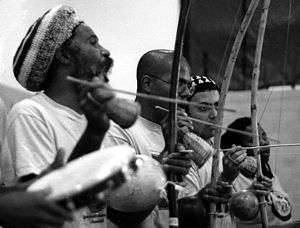War dance
For other uses, see War dance (disambiguation).

A war dance is a dance involving mock combat, usually in reference to tribal warrior societies where such dances were performed as a ritual connected with endemic warfare. Martial arts in various cultures can be performed in dance-like settings for various reasons, such as for evoking ferocity in preparation for battle or showing off skill in a more stylized manner. It could also be for celebration of valor and conquest. Many such martial arts incorporate music, especially strong percussive rhythms.
War dances
Examples of such war dances include:

Capoeira is a martial art traditionally performed with a dance-like flavor and to live musical accompaniment, as seen depicted here.
- Al-Arda al-Barriya - In Kuwait.[1]
- it-Taḥṭīb in Egypt
- Al-Yolah rifle performance - Oman and the United Arab Emirates
- Ayyalah - Qatar
- Khattak - Afghanistan and Pakistan
- Panther Dance - Burmese Bando with swords (dha)
- Baris from Bali, Indonesia
- Cakalele - Maluku, Indonesia
- Kabasaran - Minahasa people, North Sulawesi, Indonesia
- Aduk-Aduk - Brunei
- Haka - Māori people of New Zealand
- Cibi - Fiji
- Hopak - Ukraine
- Hula & Kapu Kuialua -- Native Hawaiians
- Kailao - Wallis, adopted by Tonga
- Gymnopaedia - ancient Sparta
- Pentozali - Crete
- European Sword dance or Weapon dance of various kinds
- Dirk dance and Scottish sword dances - Scotland
- Sabre Dance - depicted in Khachaturian's ballet Gayane
- Buza - From Russia
- Yarkhushta (Յարխուշտա) - Armenia
- Khorumi (ხორუმი) - Georgia
- Indlamu - Zulu people
- Maasai moran (warrior age-set) dances
- Bende War Dance [Nigeria - Abia State] Ogbuebulle
- Brazil's Capoeira, as well as some similar Afro-Caribbean arts
See also
References
- ↑ "Customs and Traditions in Kuwait". Retrieved 2013-05-03.
This article is issued from Wikipedia - version of the 7/25/2016. The text is available under the Creative Commons Attribution/Share Alike but additional terms may apply for the media files.